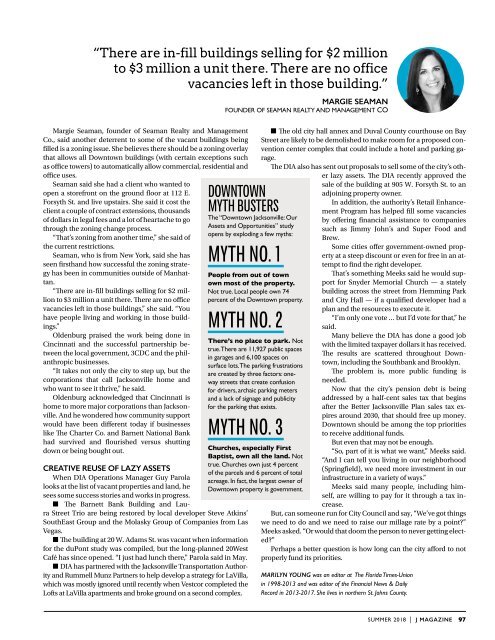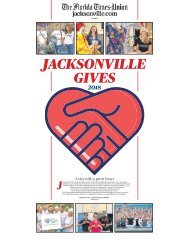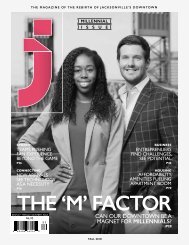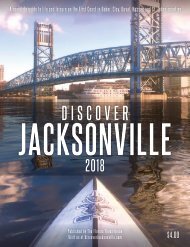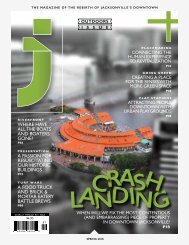J Magazine Summer 2018
The magazine of the rebirth of Jacksonville's downtown
The magazine of the rebirth of Jacksonville's downtown
Create successful ePaper yourself
Turn your PDF publications into a flip-book with our unique Google optimized e-Paper software.
“There are in-fill buildings selling for $2 million<br />
to $3 million a unit there. There are no office<br />
vacancies left in those building.”<br />
Margie Seaman, founder of Seaman Realty and Management<br />
Co., said another deterrent to some of the vacant buildings being<br />
filled is a zoning issue. She believes there should be a zoning overlay<br />
that allows all Downtown buildings (with certain exceptions such<br />
as office towers) to automatically allow commercial, residential and<br />
office uses.<br />
Seaman said she had a client who wanted to<br />
open a storefront on the ground floor at 112 E.<br />
Forsyth St. and live upstairs. She said it cost the<br />
client a couple of contract extensions, thousands<br />
of dollars in legal fees and a lot of heartache to go<br />
through the zoning change process.<br />
“That’s zoning from another time,” she said of<br />
the current restrictions.<br />
Seaman, who is from New York, said she has<br />
seen firsthand how successful the zoning strategy<br />
has been in communities outside of Manhattan.<br />
“There are in-fill buildings selling for $2 million<br />
to $3 million a unit there. There are no office<br />
vacancies left in those buildings,” she said. “You<br />
have people living and working in those buildings.”<br />
Oldenburg praised the work being done in<br />
Cincinnati and the successful partnership between<br />
the local government, 3CDC and the philanthropic<br />
businesses.<br />
“It takes not only the city to step up, but the<br />
corporations that call Jacksonville home and<br />
who want to see it thrive,” he said.<br />
Oldenburg acknowledged that Cincinnati is<br />
home to more major corporations than Jacksonville.<br />
And he wondered how community support<br />
would have been different today if businesses<br />
like The Charter Co. and Barnett National Bank<br />
had survived and flourished versus shutting<br />
down or being bought out.<br />
Creative reuse of lazy assets<br />
When DIA Operations Manager Guy Parola<br />
looks at the list of vacant properties and land, he<br />
sees some success stories and works in progress.<br />
n The Barnett Bank Building and Laura<br />
Street Trio are being restored by local developer Steve Atkins’<br />
SouthEast Group and the Molasky Group of Companies from Las<br />
Vegas.<br />
n The building at 20 W. Adams St. was vacant when information<br />
for the duPont study was compiled, but the long-planned 20West<br />
Café has since opened. “I just had lunch there,” Parola said in May.<br />
n DIA has partnered with the Jacksonville Transportation Authority<br />
and Rummell Munz Partners to help develop a strategy for LaVilla,<br />
which was mostly ignored until recently when Vestcor completed the<br />
Lofts at LaVilla apartments and broke ground on a second complex.<br />
Margie Seaman<br />
founder of SeamAn Realty and Management Co<br />
DOWNTOWN<br />
MYTH BUSTERS<br />
The “Downtown Jacksonville: Our<br />
Assets and Opportunities” study<br />
opens by exploding a few myths:<br />
MYTH NO. 1<br />
People from out of town<br />
own most of the property.<br />
Not true. Local people own 74<br />
percent of the Downtown property.<br />
MYTH NO. 2<br />
There’s no place to park. Not<br />
true. There are 11,927 public spaces<br />
in garages and 6,100 spaces on<br />
surface lots. The parking frustrations<br />
are created by three factors: oneway<br />
streets that create confusion<br />
for drivers, archaic parking meters<br />
and a lack of signage and publicity<br />
for the parking that exists.<br />
MYTH NO. 3<br />
Churches, especially First<br />
Baptist, own all the land. Not<br />
true. Churches own just 4 percent<br />
of the parcels and 6 percent of total<br />
acreage. In fact, the largest owner of<br />
Downtown property is government.<br />
n The old city hall annex and Duval County courthouse on Bay<br />
Street are likely to be demolished to make room for a proposed convention<br />
center complex that could include a hotel and parking garage.<br />
The DIA also has sent out proposals to sell some of the city’s other<br />
lazy assets. The DIA recently approved the<br />
sale of the building at 905 W. Forsyth St. to an<br />
adjoining property owner.<br />
In addition, the authority’s Retail Enhancement<br />
Program has helped fill some vacancies<br />
by offering financial assistance to companies<br />
such as Jimmy John’s and Super Food and<br />
Brew.<br />
Some cities offer government-owned property<br />
at a steep discount or even for free in an attempt<br />
to find the right developer.<br />
That’s something Meeks said he would support<br />
for Snyder Memorial Church — a stately<br />
building across the street from Hemming Park<br />
and City Hall — if a qualified developer had a<br />
plan and the resources to execute it.<br />
“I’m only one vote … but I’d vote for that,” he<br />
said.<br />
Many believe the DIA has done a good job<br />
with the limited taxpayer dollars it has received.<br />
The results are scattered throughout Downtown,<br />
including the Southbank and Brooklyn.<br />
The problem is, more public funding is<br />
needed.<br />
Now that the city’s pension debt is being<br />
addressed by a half-cent sales tax that begins<br />
after the Better Jacksonville Plan sales tax expires<br />
around 2030, that should free up money.<br />
Downtown should be among the top priorities<br />
to receive additional funds.<br />
But even that may not be enough.<br />
“So, part of it is what we want,” Meeks said.<br />
“And I can tell you living in our neighborhood<br />
(Springfield), we need more investment in our<br />
infrastructure in a variety of ways.”<br />
Meeks said many people, including himself,<br />
are willing to pay for it through a tax increase.<br />
But, can someone run for City Council and say, “We’ve got things<br />
we need to do and we need to raise our millage rate by a point?”<br />
Meeks asked. “Or would that doom the person to never getting elected?”<br />
Perhaps a better question is how long can the city afford to not<br />
properly fund its priorities.<br />
Marilyn Young was an editor at The Florida Times-Union<br />
in 1998-2013 and was editor of the Financial News & Daily<br />
Record in 2013-2017. She lives in northern St. Johns County.<br />
SUMMER <strong>2018</strong> | J MAGAZINE 97


